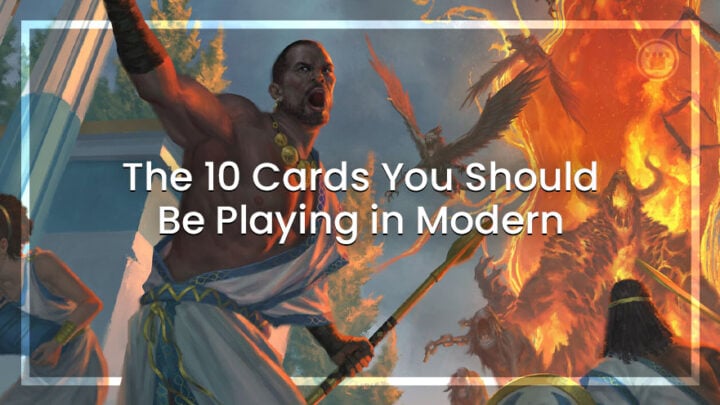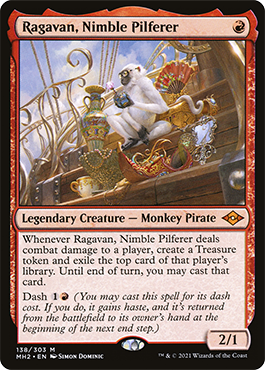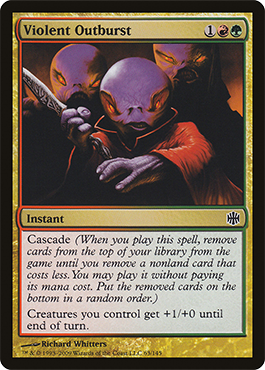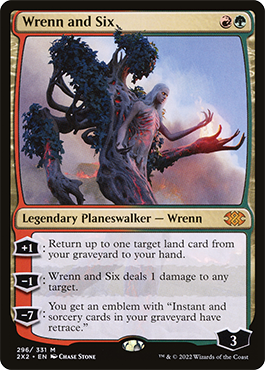Currently, Modern is about the most powerful it has ever been. The average card quality in decks is significantly higher than it has been in the past. Along with that, the best cards in the format are even more noticeable. Naturally the best decks almost always play at least a couple of the best cards in the format, unless they’re doing something incredibly specific. Chances are if a deck doesn’t play at least a couple of these cards that it likely isn’t going to give you the best chance to win. With that being said let’s take a look at 10 cards you should be playing in your Modern decks.
Ragavan, Nimble Pilferer
Ragavan, Nimble Pilferer has been one of, if not the premier threat in Modern. One of the challenges for one mana creatures in Modern is to stay relevant after turn three or four as the size and power level of creatures rises significantly at that point. Ragavan is good early to apply pressure, and generate extra mana, but also good late because you’ll be able to pair your opponent’s spell with your own in the same turn more often. Because of Ragavan’s Dash ability, it remains safe from sorcery speed removal such as Prismatic Ending and Wrenn and Six, while still finding its way into the red zone.
Ragavan excels in aggressive or up-tempo strategies like Zoo and Murktide, but it also lets midrange decks take an aggressive stance, something that was hard to do until our favorite monkey pirate made its way into Modern. If your deck is looking for a cheap threat that also scales well, I would look no further than Ragavan.
Expressive Iteration
With the likes of Ponder and Preordain being banned in Modern, Expressive Iteration is by far the best card draw spell that Modern has seen since those bans. Two mana is historically the death of most draw spells in formats as powerful as Modern, but it turns out that Expressive Iteration often reads “look at three cards and draw two of them,” and that is good enough. When you’re digging for a land so that you don’t miss one for the turn, it is frequently found with other spells that you’ll have to give up in the process, but Expressive Iteration lets you take the land without having to give up on a spell.
Expressive Iteration is often found in decks like Murktide and Underworld Breach decks to maximize the amount that you can get two cards off of an Iteration cast in the early parts of the game. Outside of a Ponder or Preordain unbanning, which I doubt we’ll see any time soon, Expressive Iteration is the gold standard for cheap card selection, and advantage.
Spell Pierce
I’ve been playing competitive Modern for over a decade, and I can’t think of a time that I’ve seen more main deck copies of Spell Pierce than right now. Modern decks right now for the most part operate in two bands: Hyper-lean, and slow-and-clunky. Decks that are hyper lean, like Murktide, Hammer, and Cascade-based decks are all vulnerable to Spell Pierce because they are using so much of their mana every turn from the start of the game that it is genuinely difficult to not find an acceptable use for Spell Pierce.
In those hyper lean matchups tempo tends to be incredibly important, so being able to trade up on mana, or deploy and protect a threat in the same turn can easily turn the tide of a game. Against the clunkier decks, Creativity for example, Spell Pierce is particularly effective since they are casting Fable of the Mirror-Breaker, and Indomitable Creativity. Such cards will often take an entire turn to cast, or put your opponent multiple turns behind the curve. Countering an expensive sorcery speed threat while adding pressure to the board goes a long way to win games of Modern.
Urza’s Saga
Gone are the days of Raging Ravine and Celestial Colonnade serving as a win condition for slower decks. Lands that can become a creature have historically been a good way for decks to reduce the impact of flooding, and Urza’s Saga is the best in the business. A land that can produce two (generally large) creatures, and then either tutor a utility artifact, or even a combo piece in the case of Amulet of Vigor and Colossus Hammer, is so far above rate from the old creature lands that they aren’t even close in terms of power.
Urza’s Saga finds a home in both combo decks, such as Hammer, Amulet, and Breach, while also showing up in fair strategies like Jund. The most obvious pitfall that keeps Urza’s Saga from being ubiquitous is that it doesn’t make colored mana. The bigger midrange and control decks in Modern tend to be four or five colors, simply making it too hard to support Urza’s Saga.
Violent Outburst
During Violent Outburst’s time in the sun the cards around it have changed, but one thing remains constant: Violent Outburst is the best card in Cascade strategies. Rhinos, and even more so Living End, really dislikes trying to beat counterspells. Violent Outburst not only enables you to hit your cascade payoff on a turn that maybe your opponent tapped out of countermagic, but if you have another Violent Outburst or Shardless Agent you can make your opponent burn their counter on their end step, before going for it again on your turn. Violent Outburst has the secret text of turning Force of Negation into Cancel, meaning that as long as you go for it on the opponent’s turn you can easily beat the first counter. This is an especially strong play pattern in Living End, which will almost always win the game after resolving a Living End. Violent Outburst wants you to do something very specific to make it good, but once you’re trying to cast Living End or Crashing Footfalls, Violent Outburst is the best enabler by a long shot.
Underworld Breach
Underworld Breach is the newest card in Modern to skyrocket in play. Underworld Breach had been dormant for a while, until the Jeskai Grinding Breach decks started making noise. Those Breach combo decks flew under the radar for a while, but eventually gained the respect of being among Modern’s strongest decks, and that was in no small part due to Underworld Breach.
While Underworld Breach isn’t exactly Yawgmoth’s Will, it feels like pulling an Underworld Breach mask off a Scooby Doo villain to reveal Yawgmoth’s Will. Exiling three cards per spell you want to cast isn’t cheap at face value, when you consider, well…Consider, Dragon’s Rage Channeler, and all the cheap spells in Modern, that limitation stops mattering very quickly.
Underworld Breach is so powerful that the Grinding Station combo decks have begun cutting the combo elements and just playing Underworld Breach as a strong value card. Sometimes you draw a bunch of cards by chaining Mishra’s Bauble, sometimes you play a couple removal spells, maybe a threat, and other times you just Lightning Bolt someone four times and end the game. Whether you’re looking to play fair, or combo, aggressive or midrange, if you’re playing all but the slowest decks with the access to red, Underworld Breach should be on your radar.
Fury
One of the evoke elementals had to make the list, right? Given the current Modern climate, I think that Fury is the best of the bunch, though Solitude and Subtlety aren’t far behind. Whether you’re trying to sweep up a bunch of small creatures against Hammer, or take down Omnath, Locus of Creation, Fury can get the job done. You’ll often see Fury paired with Ephemerate or Feign Death to double dip on its trigger, and also leave behind a formidable body. In matchups where speed is important, one of the best plays that Rakdos Scam can make is putting a 4/4 Fury into play on turn one. While not quite as effective as Feign Death, Ephemerate out of an elementals deck can serve a similar purpose, Feign Death being better for aggression, and Ephemerate for control. Free spells shouldn’t be underestimated, especially when they’re as powerful at swinging a game as Fury. Slower red decks should be on the lookout to include Fury if possible.
Leyline Binding
Leyline Binding is technically a white card, but in reality is a five color card. In Modern, five color mana-bases are either painful and heavy with shock lands, or slow and playing a lot of triomes. The thing about being slow in Modern is that you risk getting run over by the hyper lean strategies. Leyline Binding being castable on turn two off of two triomes means that you have great mana, and can get some pressure off of yourself as you try to set up your more powerful three and four mana spells. Leyline Binding is about as efficient as it gets in Modern; point and click removal, for any nonland permanent, at instant speed, all for one mana is an insane rate. Most slower Modern decks are already playing four or more colors, so the changes that you’d need to make to existing mana to make Leyline Binding work are minimal.
Wrenn and Six
Wrenn and Six has been regarded as one of the most powerful planeswalkers ever printed, which puts it in rare company, and honestly I believe that to be correct. A two mana planeswalker that gets out of Lightning Bolt range the turn you play it is already interesting. Wrenn also defends against some of the marquee threats in the format gunning down early Ragavans, Dragon’s Rage Channelers, and Esper Sentinels with ease. As long as you have a fetch land in your graveyard, Wrenn will make sure that not only will you not miss a land drop, but that your mana will develop perfectly. Picking up a land every turn is particularly powerful when combined with Fable of the Mirror-Breaker, turning the second chapter into Divination, but on a delay. Eventually Wrenn will threaten to ultimate if not respected, which nearly always results in winning the game either by having nearly unlimited interaction, or a pile of Lightning Bolts. Slower decks with access to red and green should strongly consider Wrenn and Six, and a lot of them.
Blood Moon
Last but not least, we have Blood Moon. I did just finish going over how greedy you can be with Modern mana thanks to cards like Wrenn and Six, and getting paid off with cards like Leyline Binding. Well, the counter to that is to just tell your opponent that they were too greedy, and their punishment is that now they only have Mountains. I’ve been a strong proponent of Blood Moon for a while now as Modern mana continues to get greedier and greedier. Before the Yorion, Sky Nomad ban, Blood Moon seemed like the answer to the four and five color decks, but they filled those extra 20 cards with some basic lands, and Abundant Growths, making Blood Moon fairly weak. Now that everyone has agreed to playing with 60 cards again those four color mana-bases are much weaker to Blood Moon. Creativity is another large player in the metagame that gets hosed by Blood Moon. All in all, if you’re playing a two and to some degree maybe even three color deck with red, Blood Moon is one of the single strongest cards that you can register at the moment.
Modern Times
By no means is this list definitive or exhaustive, but more so the cards that I believe are among the best in Modern, that you should seriously consider playing if you can. There are decks (like Yawgmoth, for example) that don’t have any of these cards that are still successful, but they’re more of the exception to the rule. When I’m looking to choose a deck for a weekend, I’m often looking at this, or a similar list of cards, and figuring out how many of them I can get in one place, given how important card quality is in Modern currently.
As always you can find me for questions, comments, or feedback on Twitter at @RappaciousOne. I’ll see everyone back here next week!

Michael Rapp is a Modern specialist who favors Thoughtseize decks. Magic sates his desire for competition and constant improvement.











